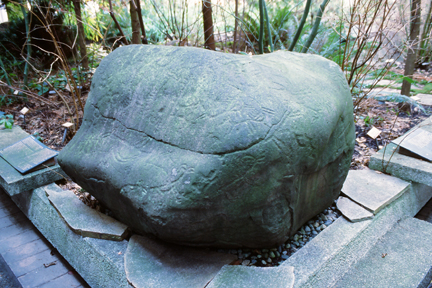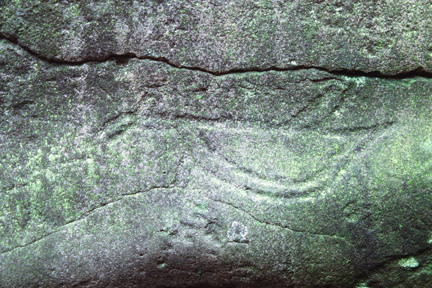
Petroglyph from Lone Creek Cabin, Stl’atl’imx Territory, now in an outdoor courtyard at the Museum of Vancouver. Source: Squamish-Lil'wat Centre.
I’ve posted before on the large petroglyph boulder from the central Fraser River that is being kept in a sub-standard context at the Museum of Vancouver. I found some more pictures of it, from the website of the Squamish-Lil’wat Cultural Centre (which is excellent). These additional pictures confirm there is a serious conservation issue at the Museum of Vancouver. I don’t want to beat a dead horse but I am still mad about this situation. The pictures below pretty much speak for themselves – this work of art has not being cared for properly. I’d love to know more about whether the Museum of Vancouver even thinks this is a problem. The pictures below show details of the declining clarity of the carved designs. I wish this was the MoV’s priority, rather than the opaque public relations speak that informs their ugly and disrespectful website – the design principles of which you can read about here:
an extensive visioning process that changed its strategic direction to focus exclusively on Vancouver [the petroglyph is not from Vancouver – editor]. Kaldor was selected through an RFP process to create a new brand strategy, brand identity, Website, indoor and outdoor signage, stationery, membership and corporate brochures e-newsletter and ad templates.
A little less of that, and a little more conservation would be in order, MoV. Conserve, or repatriate: I don’t see any other options.







The pic from the 1930s looks TOO clean – given that the figures were probably produced over a long period of time, they look too consistent with each other. My guess is that the designs were ‘freshened up’ with some fresh abrasion when the stone was prepared for display at Stanley Park (what were they thinking? Oh, yeah, ‘curio’). A lot of the spalling appears to be present (and fresh) on the historical photo too – I imagine they damaged it with picks getting chains underneath, and probably the chains damaged the rock when it was lifted. I think it would take some detailed study to determine just what changes have taken place since the 1930s.
LikeLike
Pingback: Signs of Respect « Time Machine by Heather Pringle
Harlan I Smith included this petroglyph in his publication “A List of Petroglyphs in British Columbia”, American Anthropologist, Vol. 29, No. v, October-December, 1927.
The full entry is:
“Half way between Lone Cabin creek and Big bar, Fraser river (Reported as being moved to Vancouver).”
Of interest also in the article is that it includes a copy of the BC Historic Objects Preservation Act of 1925. This act offered protection to rock art in particular, though each rock art site had to be designated by Order in Council. Even so, it is interesting that there was clearly a political and therefore public interest in protection of rock art prior to the removal of this boulder. In a sense, the persons that moved this boulder, while acting within the technicalities of the Act, were acting contrary to the spirit of the legislation.
Below is the text of the Act since it is both short and of historical interest (to me anyway):
Certified correct as passed Third Reading on 16th December, 1925.
C. K. COURTNEY, Law Clerk
HON. PROVINCIAL SECRETARY
BILL
No. 66) (1925
An Act to Provide for the Preservation of Historic Objects
HIS MAJESTY, by and with the advice and consent of the Legislative Assembly of the Province of British Columbia, enacts as follows:
1. This Act may be cited as the “Historic Objects Preservation Act.”
2. The Lieutenant-Governor in Council may declare any primitive figure or legend cut in or painted upon rock, or any group of such figures or legends, or any structure, or any natural object existing within the Province to be a “historic object” within the meaning and scope of this Act, and may make provision for the erection and maintenance in the vicinity of such historic object of a notice referring to this Act, in such form as may be deemed advisable.
3. Where a notice has been erected in the vicinity of any historic object pursuant to this Act, no person shall, except pursuant to a permit in writing of the Provincial Secretary first obtained, remove, deface, obliterate, alter,
add to, or otherwise interfere with that historic object, or the notice so erected, nor shall any person cut, or carve, or write, or paint any figure, legend, or name in or upon any rock or material comprised in or appurtenant to that historic object.
4. Every person violating any provision of section 3 shall be liable, on summary conviction, to a fine not exceeding five hundred dollars.
VICTORIA, B. C.:
Printed by CHARLES F. BANFIELD, Printer to the King’s Most Excellent Majesty 1925
LikeLike
Hi Morley — that’s an interesting idea that they freshened it up some. I bet someone took pictures of the moving operation. But you know those shallow petroglyphs which really just remove a thin weathering rind could be quite vivid and durable — if you remove 10,000 years of weathering and then let it weather for 300 years, say, it might still look brand new. Suppositional, I know, but I could see it both ways.
APM — that’s a great citation to that piece of legislation. It is striking that in the 1920s there was suficient recognition here in the wild west for such a bill to be deemed necessary – considering aboriginal people couldn’t even vote it is remarkable in some ways.
LikeLike
Perhaps even more remarkable is that under that piece of legislation some sacred non-archaeological places were designated by Order-in-Council during the 1920’s. Included for instance is a coyote transformer stone (known to some parts of society as an enormous erratic) in the dry interior. Clause 2 in the HOPA is a bit hard to understand with that string of “ors”, but I am guessing that the authority for that protection is the “any natural object” sub-clause.
These sites are still protected by the current version of the legislation, the Heritage Conservation Act. Any one familiar with the rock art in East Sooke Park will find a copper plaque on the site declaring its protection under HOPA. I am sure other of these plaques exist around BC, and they too are still protected from alteration by the HCA.
LikeLike
Yes, there is a plaque in the upper bella coola valley (stuix area, along way from the surf) associated with rock art and apparently box burials (removed) in nearby rockshelter, dedicated in 1937. Has anyone ever found details associated with these HOPA designations??
LikeLike
If anyone has watched the history of US National Parks on Channel 9 (I still call it that) it is fascinating how laws were passed to allow the US president to protect the archaeological values in the cliff dwellings, and Teddy Roosevelt used the powers it gave the president to protect natural environments as well, like the Grand Canyon and Yosemite. I’ve always thought of archaeology as being tagged on to ‘heritage’ or ‘environmental’ causes, when in actuality it has actually led in many cases.
The max $500 fine in the 1920s would be $6,255.43 in 2010 dollars according to the Bank of Canada Inflation Calculator – not as much as I would have thought.
LikeLike
Just the difference in the amount of rain from the area it comes from would account for much of the erosion taking place in the present location now. If the its not moved indoors or put back in its original environment it will only continue. Perhaps a glass cover may help? I personally love visiting the one at the Stein River and Fraser River regularly.
LikeLike
Too bad canada outlawed 1st Nation (indian) Peoples culture, history & imposed the fear of residential schools while keeping them captive on plots of land (like the Chinese during WW2). The history was hidden, not shared & now most oral histories have died with the holders. These “rock art” markers are written from the time of the creation of “turtle island”. When you know the right people one learns about Creation, the Peoples prior to euro contact, contact & the future of all the people who are here now. They are laws and timelines…
LikeLike